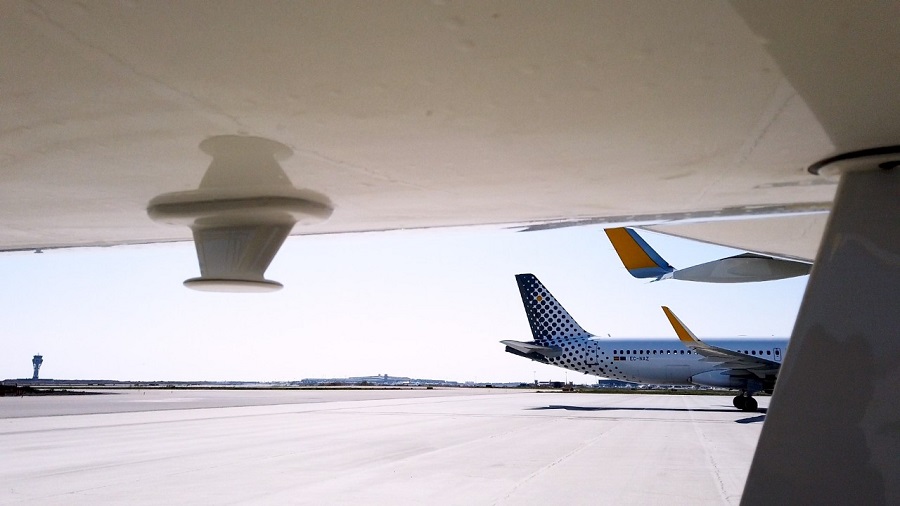A year of EAN marked by significant increase in throughput to the aircraft
Europe’s fastest and most sophisticated inflight broadband solution – the European Aviation Network, commonly known as EAN – has just got better. This is the story of how and why…
A lot can happen in a year. Particularly in aviation. And especially in the fast-moving world of inflight connectivity. When British Airways became the first airline to offer the European Aviation Network (EAN) commercially in March 2019, it was quite rightly heralded as the most sophisticated inflight broadband solution in Europe.
The last 12 months have borne out such an assertion. Designed as a bespoke response to European aviation’s unique set of circumstances – its dense airspace, a high number of key aircraft hubs close to each other and ever-rising passenger numbers – EAN has exceeded all expectations.
In total, 7.6m British Airways passengers alone have been exposed to the service. There have been a significant number of sessions each day, with an average session lasting one hour and consuming 120MB. Over the wider International Airlines Group (IAG) this increases to 16.5m passengers exposed to EAN, with a session lasting an hour on average and a data rate consumption at 150MB per session.
Optimising performance parameters
And thanks to the dedication and hard work of Inmarsat, Deutsche Telekom and its partners, there is more good news for airlines and their passengers. Rather than the peak data rates of 75Mbps that were originally expected to be delivered to the aircraft upon launch – and were considered disruptive within the industry – efforts to optimise EAN’s performance parameters have resulted in an increase to an impressive 100Mbps.
Sonia Berube-Ray, Inmarsat’s Director of EAN Technology, says these measured performances are really encouraging, because rather than theoretical models based upon lab testing and test flights, these figures come from real-life data from a live network in operation with real-life constraints. “This is very reassuring and represents a 30-35% increase in peak capability relative to the initial estimate,” she enthusiastically explains.

A real team effort
Berube-Ray points out that this hasn’t been achieved by one service enhancement or a one-off flick of a single switch. Rather she highlights the industrious team effort, maintained over 12 months, that has led to a gradual increase. “This has been a collection of daily tasks and activities, led by the many EAN stakeholders both inside and outside Inmarsat and Deutsche Telekom,” she says. “The teams have worked tirelessly to monitor and improve the overall performance of the network.”
This has included documenting and addressing any improvement opportunities in coverage; quickly reviewing behavior of individual aircraft equipment and aligning and implementing improvements with equipment suppliers.
Alongside this, there have been regular discussions with airlines concerning the in-service performance data collected and addressing any additional needs they might have. “This is done continuously,” she affirms. “And that helped us to get to where we are today. This also goes for improving other key aspects like latency and even focusing on getting the network as stable as possible so we can even more reliably deliver the service.”
Dr. Matthias Siebert, Deutsche Telekom’s Head of Airspace Mobile Solutions and responsible for EAN, says the approach taken to report and measure schemes that are then sent back to the network, and then used to improve it, was certainly the correct one. He calls this mechanism the “heartbeat”. “This heartbeat,” he notes, “is a permanent, real-life trigger that includes system data, radio performance data, interference data, the geo-location, time stamp… whatever an engineer requires to measure and improve the service.”
Siebert says that every flight over the last year has helped produce a grid of data. Over time this grid of data became statistically more relevant. “Outliers could be taken out for example,” he explains. “And from there we could identify structures. Based on these structures we could then initiate concrete actions.”
Delivering a better service
There are other elements that can be identified as driving this improvement in performance. Siebert says that in particular the unique 4G LTE technology tailored for aviation that is used in EAN is capable of instantaneously and automatically identifying and using any surplus performance margin on the radio link. This performs a critical role. “It means if there even is a little bit of spare room there the system will try to take advantage of it to deliver a better service,” he explains.
Refining and optimizing the network’s configuration settings has also enabled the incremental release of additional capacity for use by airlines. This has also resulted in even better peak throughputs. Another tangible step change has seen Inmarsat successfully deploy updates to the Thales OBE software on the aircraft. This has resulted in a noticeable increase to the EAN availability and throughput performance seen by customers.
Additionally, Deutsche Telekom has now upgraded the network with the latest Nokia AirScale base station technology to more than 90% of the sites, with the rest to be deployed in the coming weeks. This too has resulted in a tangible boost to the performance of the service delivered to customers.
A boon for airlines and their passengers
So, crucially, what does this mean for airlines and their passengers? Well, for data-hungry flyers it means a lot – an increase of 30% bandwidth will satisfy super-connected, always-on passengers. “It means many more passengers simultaneously streaming video and transferring big files,” confirms Berube-Ray.

“There’s a lot of buzz about online gaming too – so that means many more passengers can work at ridding the world of “Husks” in Fortnite, sending business critical emails and presentations through their company’s VPN or even attending an online meeting without frustrating buffering or interruptions.”
Significantly, this increase in throughput means that airlines can leverage EAN to support or even enhance important crew operations without worrying about impacting their passengers’ in-flight connectivity experience. “There is no need for compromise,” notes Berube-Ray. “Airlines won’t have to choose between the level of service they want to provide to their passengers and the level of service its crew can have access to concurrently.”
In other good news, this enhancement is available immediately to existing and new customers alike. And for the most part, it requires no new hardware or software upgrades to take advantage of the performance improvements. “Any performance improvements relying on new onboard software release are carefully thought through,” she confirms. “Any design, development, certification and deployment activities are closely coordinated between us, the hardware manufacturer and of course the airlines to ensure as little impact as possible to the airline’s operations.”
Finally, this service improvement is available across the network – not just major hubs like London, Paris or Amsterdam. “Absolutely,” Berube Ray is quick to point out. “Whether you fly to Warsaw or Valencia… or more recently we can claim Bucharest for example. It doesn’t matter. Each country and region is equally important for our European short-haul coverage. So, we’ve been focusing on the entirety of the network.”
Of course, how airlines choose to use this increased capacity is predicated against a number of considerations: passengers’ habits, chosen business cases and retail propositions. “A few of our airlines have elected to tailor the IFC plans they offer to specific user’s needs such as messaging-only or perhaps browsing,” explains Berube-Ray. “And eventually an upper tier plan including streaming capability. Some are even expanding the envelope slightly with an ‘all-you-can-eat’ type of package but are still hesitant to move forward without at least some restrictive mechanism to control the data usage.”
To that end, Berube-Ray points out that Inmarsat is eager to work with airlines so they can get the most from this increased maximum capacity. “We would be delighted to expand our work with existing and new airlines to define creative offerings that would ‘unleash the EAN beast’ while still ensuring fair usage between passengers and allow the airline a solid ROI,” she says.
The best gets better
EAN is a complete game-changer for European aviation. At a time when an already busy airspace is predicted to get even more congested – before the current Covid-19 pandemic, the continent’s current one billion annual passengers was forecast to swell by half again to reach 1.5bn come 2035 - EAN’s fast scalability, the quickest on the market, will enable capacity to be delivered where and when required, ensuring rising passenger expectations will be met. And because the system has an installation time of just seven hours, aircraft spend up to 80% less time on the ground than with competing solutions. Which all helps when it comes to ROI.
Then there’s EAN’s economic capabilities. It can not only make money through unlocking the potential of ancillary revenue streams, it can save money via a suite of operational efficiencies. And thanks to the diligence, pride and enquiring nature of Inmarsat, Deutsche Telekom and its partners, the best has just got better.
“It wasn’t the case that airlines came to us and told us to make it better,” says a satisfied Siebert. “It was our own intrinsic motivation. We knew 100Mbps was possible. When we first started we had good results, but we knew there was optimisation potential.”
He believes that this remarkable throughput increase is testament to Inmarsat, Deutsche Telekom and its partners’ commitment to the service. “We are making a conscious effort to continuously build on the network, and improve it,” he stated.
Berube-Ray concludes: “We are constantly thinking about the roadmap and what it means for existing and future customers to have a network that continues to grow and support more passengers, more devices, more applications and more revenue generating services. We’re proactively providing this additional capacity without being asked for it.”
SOCIAL MEDIA